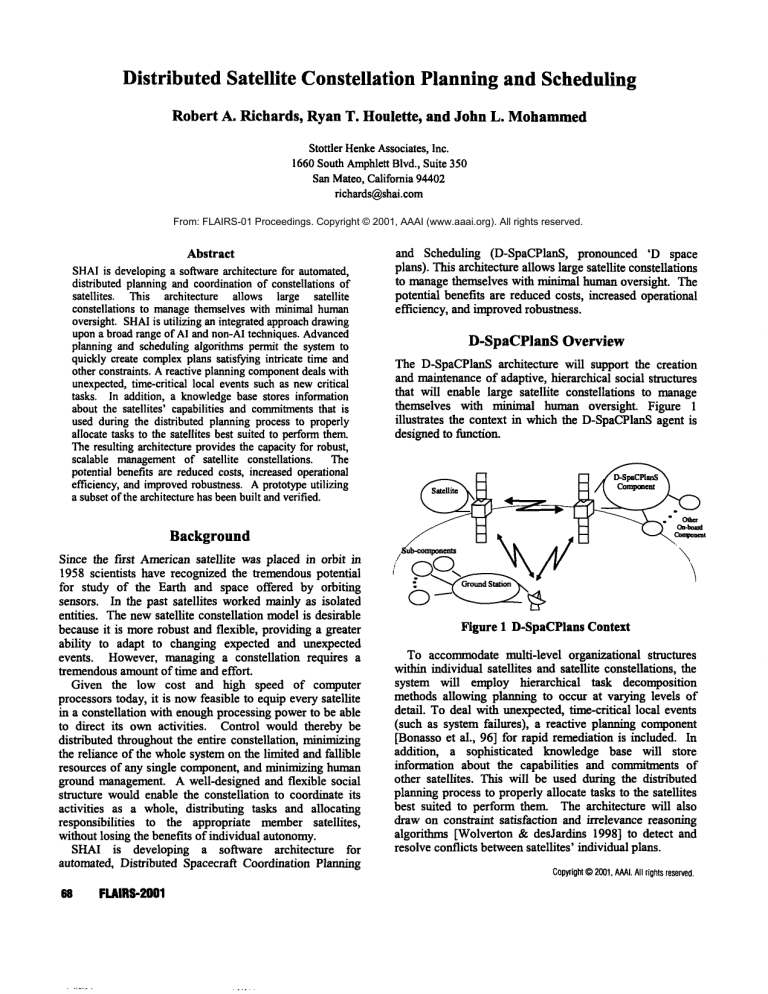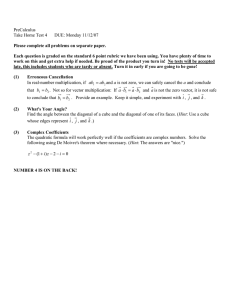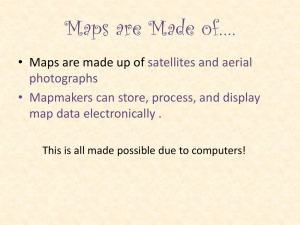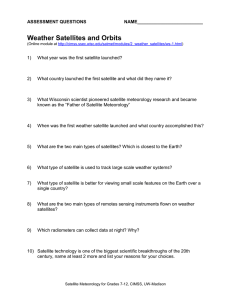
Distributed Satellite
Constellation Planning and Scheduling
Robert A. Riehards,
Ryan T. Houlette,
and John L. Mohammed
Stottler HenkeAssociates,Inc.
1660SouthAmphlettBlvd., Suite 350
San Mateo,California 94402
richards@shai.corn
From: FLAIRS-01 Proceedings. Copyright © 2001, AAAI (www.aaai.org). All rights reserved.
Abstract
SHAIis developinga software architecture for automated,
distributed planningand coordinationof constellations of
satellites. This architecture allows large satellite
constellations to managethemselveswith minimalhuman
oversight. SHAIis utilizing an integrated approachdrawing
upona broadrange of A! and non-Altechniques. Advanced
planning and scheduling algorithms permit the systemto
quicklycreate complexplans satisfying intricate time and
other constraints. Areactive planningcomponent
deals with
unexpected,time-critical local events such as newcritical
tasks. In addition, a knowledgebase stores information
about the satellites’ capabilities and commitments
that is
used during the distributed planningprocess to properly
allocate tasks to the satellites best suited to performthem.
Theresulting architectureprovidesthe capacityfor robust,
scalable management
of satellite constellations. The
potential benefits are reducedcosts, increasedoperational
efficiency, and improvedrobustness. Aprototypeutilizing
a subsetof the architecturehas beenbuilt andverified.
and Scheduling (D-SpaCPlanS, pronounced ’D space
plans). This architecture allowslarge satellite constellations
to managethemselves with minimal humanoversight. The
potential benefits are reduced costs, increased operational
efficiency, and improvedrobustness.
D-SpaCPIanS
Overview
The D-SpaCPlanSarchitecture will support the creation
and maintenanceof adaptive, hierarchical social structures
that will enable large satellite constellations to manage
themselves with minimal human oversight. Figure 1
illustrates the context in which the D-SpaCPlanSagent is
designedto function.
Background
Since the first Americansatellite was placed in orbit in
1958 scientists have recognized the tremendous potential
for study of the Earth and space offered by orbiting
sensors. In the past satellites workedmainly as isolated
entities. The newsatellite constellation modelis desirable
because it is morerobust and flexible, providing a greater
ability to adapt to changing expected and unexpected
events. However, managing a constellation requires a
tremendousamountof time and effort.
Given the low cost and high speed of computer
processors today, it is nowfeasible to equip every satellite
in a constellation with enoughprocessing powerto be able
to direct its own activities. Control would thereby be
distributed throughout the entire constellation, minimizing
the reliance of the wholesystemon the limited and fallible
resources of any single component, and minimizing human
ground management. A well-designed and flexible social
structure wouldenable the constellation to coordinate its
activities as a whole, distributing tasks and allocating
responsibilities to the appropriate membersatellites,
without losing the benefits of individual autonomy.
SHAI is developing a software architecture
for
automated, Distributed Spacecraft Coordination Planning
68
FLAIRS-2001
Figure 1 D-SpaCPlans Context
To accommodatemulti-level organizational structures
within individual satellites and satellite constellations, the
system will employ hierarchical task decomposition
methods allowing planning to occur at varying levels of
detail. To deal with unexpected,time-critical local events
(such as system failures), a reactive pla~aning component
[Bonassoet al., 96] for rapid remediation is included. In
addition, a sophisticated knowledge base will store
information about the capabilities and commitmentsof
other satellites. This will be used during the distributed
planningprocess to properly allocate tasks to the satellites
best suited to perform them. The architecture will also
draw on constraint satisfaction and irrelevance reasoning
algorithms [Wolverton & desJardins 1998] to detect and
resolve conflicts betweensatellites’ individual plans.
Copyright
©2001,
AMI.
Allrigfltsreserved.
Functionality
The D-SpaCPlanSadvances the idea that efficient
distributed planning in a densely-populated networkof
autonomousentities requires someform of system-wide
organizationto structure and guide the planningprocess
(see discussion of organizations in [Durfee, 1993]).
ensurerobustnessandscalability, this organizationshould
spreadauthority and responsibility as evenlyas possible
over all its members,therebyminimizing
the impactcaused
by the introduction of newmembersor the loss of old
members
due to failure. In addition, the organizationwill
be able to reorganize itself to adapt to changesto the
membership
of the networkover time.
In D-SpaCPIanS,
the organizationalprinciples described
above manifest themselves in the form of a flexible
hierarchy of nested groups; every satellite in a given
constellation belongs to one or moreof these groups. A
roughsketchof this hierarchyis presentedin Figure2, with
solid circles representing the actual satellites in a
constellation anddifferent-sized ovals representinggroups
at different levels of the hierarchy.Thegroupsto whicha
particular satellite belongsare indicatedby the ovals that
contain it. For example,Satellite 13 is a member
of the
wholeconstellation, of GroupA, and of SubgroupAlpha.
Groupmembership
is not basedon any specific properties
of a satellite - suchas its physicallocation or functional
capabilities - but is rather an arbitrary, abstract division
whose purpose is to provide a framework for the
decompositionand distribution of the planning process
across the entire constellation. These divisions are
determinedautomaticallyby negotiation [Davis and Smith
1983]among
the satellites’ social coordinatorunits.
~mueellaaon
~’----.~S=bem~c
AIpha
~~ "~.__---- Satellge13- cerreatmanal~er
of Set.map
A~pha
constellation, whoaccepts orders directly fromthe ground
controller. Themanagement
role of the groundcontroller
is greatly simplifiedby this hierarchicalorganization,since
it needsto interact withbut a single entity in orderto direct
the activities of dozensto hundredsof satellites. Planning
occursat all levels of the hierarchy, with plans growing
moreand moredetailed the further downone goes in the
hierarchy.
It is not uncommon
for a satellite to fail in orbit for a
variety of reasons [Mohammed,
98]. Sucha failure could
be catastrophicfor a constellationthat relies heavily on a
fixed organizationalhierarchy. Imagine,for example,that
the top-level managersuddenlydies without warning. If
the satellites’ organizational scheme is unable to
compensatefor this failure, the whole constellation
becomesinaccessible and useless. In our architecture,
granting the organizational structure the capacity to
dynamicallyreorganizeitself in the face of changesto the
constellationalleviates this danger.Thereare twofacets to
this capacity.
First, group managersare designedin such a waythat
their existenceis not tied to anysingle satellite. Instead,
every satellite in a constellation possesses the ability,
withinits automated
planningarchitecture, to take over the
duties of a groupmanager.Aspart of this distribution of
the managerial role, each group managerperiodically
broadcasts the contents of its memoryto someof its
subgroups,whichstore this information. Then, whenlack
of communicationfrom a given managerindicates the
death of the hosting satellite, the membersof the nowmanagerless group cooperate to reconstruct the lost
manageron a newhost using their backupcopies of that
manager’s memory.
Second,if significant imbalancesin group size arise
(e.g., as old satellites fail and newones are added),the
constellation’s managers can also collaboratively
restructure the actual groupsthemselves:large groupscan
be split into smaller subgroups, small groups can be
merged,and groupscan evenbe traded betweenmanagers.
Satelhte
18-cnwent
ma~lagez
of Group
Ih#t7- ¢~tnumagex
of cop.ztellatlon
Figure 2 SampleOrganizational Structure
As shownin the figure, its ownautonomousmanager
governseach group at each level of the hierarchy. This
managerrecewestask assignmentsfor its group fromthe
nexthigherlevel of the hierarchyandin turn is responsible
for distributing these tasks to the most appropriate
subgroupsin the level of the hierarchyimmediately
below.
The managermakes its determination of whois most
appropriatefor a given task basedon its knowledge
of the
capabilities and current commitmentsof each of the
subgroupsbelongingto its group. At the lowest level,
managersassign tasks to the individual satellites in their
subgroups,whichthen carry out the requestedtasks. At the
top of the hierarchy resides the managerfor the whole
Figure 3 High-LevelDesign
AI IN AEROSPACE
69
Social Coordinator. The social coordinator acts as the
interface betweenthe rest of the architecture and the other
satellites in the constellation. It keeps track of all
organizational details including, amongother things, which
groups the satellite belongs to and where the various group
managersare currently residing.
The social coordinator componentdraws on technologies
from a numberof areas. At its core, a collection of rules
describing how hierarchy management should be done.
Around these general rules are a number of smaller
knowledgemodules that "know" howto deal with specific
kinds of situations. Thesespecialized modulesare activated
by the rules whenthe appropriate situation arises.
Group Manager. The group manager is the component
charged with actually directing the activities of the
constellation. In essence, its job is muchlike that of a
humanmanager: take orders from a higher-level manager
and pass themon to the right subgroupsto be carried out.
The group agenda subunit is a sophisticated knowledge
base that serves as the group manager’smemory,storing all
relevant information about the capabilities and scheduled
commitments of each of the subgroups being managed.
This information is updated by reports from the subgroups
as their commitmentschange. In turn, the group agenda
sends update reports containing a summaryof the agenda’s
information about its entire group to the manager of the
level above. Thus, the group agenda subunits of all
managers, taken together, can be considered a kind of
distributed schedule/knowledgebase for the constellation.
This knowledge base will need to be able to store and
retrieve multiple types of information, including complex
data combininggeographical and temporal parameters - for
example, "satellite 3’s infrared camerawill be available
over Honduras between 03:30 and 04:00 hours GMTon
July 16."
The second subunit is the group planner, whichtakes the
tasks given to the group manager, breaks them up into
smaller subtasks, and assigns them to specific subgroups.
At the core of this subunit sits an automatedpartial-order
planner that, using hierarchical task decomposition, is
capable of generating plans at different levels of detail
depending on the group manager’s position in the
hierarchy. For example, a plan generated by a high-level
managermight contain an abstract task like "Observeocean
currents along west coast of U.S.," while a lower-level
manager might break this very general task down into a
number of more specific tasks: "Observe 50 miles from
California shore with infrared cameras," "Observe30 miles
from Oregonshore with infrared cameras," and so on. This
hierarchical decomposition of tasks continues until
"primitive" tasks that can actually be directly acted upon
are reached. This planner relies heavily on information
provided by the group agenda to determine which
subgroupsare best suited to performa particular task.
The conflict detector is the group manager’s third
subunit. It ensures that the plans devised by different
subgroupsdo not conflict with one another (e.g., by trying
to use the same communicationschannel at the same time).
70
FLAIRS-2001
Whenconflicts are found, this subunit sends the plans back
to the subgroups that devised them with instructions about
howto revise themto avoid the conflict.
Note that the group manager component of the
architecture is only active whena manageris actually being
hosted on the satellite. Thus, for most satellites in a
constellation this componentlies dormantmost of the time,
though it alwaysremains ready to take over hosting duties
if necessary.
Local Planner/Scheduler.
Whereas the group manager
componentof the architecture handles the coordination of
groups of satellites, the local planner/scheduler component
is concerned with controlling the activities of a single
satellite, specifically the one on whichthe architecture is
running. The local planner receives its assignments from
the satellite’s group manager, then produces a complete
executable plan for completing those assignments. This
plan is sent to the group manager to be checked for
conflicts with the local plans of other satellites. If conflicts
are found, the local planner alters the plan accordingto the
manager’sinstructions; otherwise, the plan is carried out as
is. The local planner/scheduler comprises three main
subunits: deliberative planner, reactive planner, and
relevance reasoner.
The deliberative planner is an automated partial-order
planner (using SHAI’s intelligent
entities concept)
combinedwith a constraint-satisfaction-based scheduler. It
is this planner that, given the manager’stask assignments,
producesthe detailed low-level plan to carry themout. For
example, the local planner might receive the assignment,
"Observe San Francisco at 15:35:27 on August 10 with
radar." It wouldthen, using its built-in knowledgeabout
the prerequisites for different kinds of actions, determine
that in order to observeSan Franciscoat the desired time, it
will needto first point its radar at the correct location and
then actually take the observations by activating the radar.
At this point, the intelligent entity for the "pointing radar"
task wouldnote that in order to point the radar, the satellite
mustfire an attitude control jet; the entities representingthe
jets negotiate amongstthemselves to determine whichjet is
the correct one to fire. This continues until a precise plan
of action is constructed. These plans generally are for
events scheduled hours or days in advance and thus the
deliberative planner does not need to be able to plan in real
time.
Onthe other hand, the reactive planner, is a fast specialpurpose planner designed solely to allow the satellite to
react immediatelyin case of an emergency.If a solar panel
is struck by a micrometeorite, for example, the satellite
mayimmediately inform another satellite of the situation
and its commitments(which will now be abandoned) and
go into a safe-hold modeuntil an operator can intervene.
This planner does not consult with the group manager
before acting. Instead, it acts first and then informs the
managerafterwards of its actions so that the managercan
resolve any conflicts those actions might have caused.
Because it must react in seconds, and because the
remediation plans it generates are not very long, the
reactive planner does not do an in-depth, knowledgeintensiveanalysis of its situation, goals, andresourcesto
generatea plan; rather, it relies ona relatively smallset of
rules, precomputed
plans, and scripts to quicklyproducean
effective, appropriateresponse.
Thefinal component
of the local planneris the relevance
reasoner.
This subunit uses irrelevance reasoning
[Wolverton& desJardins1998] to determinewhichparts of
the plan generated by the local planner could possibly
generateconflicts with other satellites. Todo this it uses
modelsof the dependenciesbetweentasks and resources in
combination with information about the goals of the
subgroup’s other memberstransmitted by the group
manager.Onlythese relevant parts of the plan, attachedto
a skeletal plan framework,are then sent to the group
managerto be checked for conflicts. This subunit is
necessaryto keepfromwastingthe limited communications
bandwidthavailable for intra-cousteUationcommunication
on the transmissionof unimportantdata.
Local Database.Thelocal database is the repository for
all local informationstoredby the satellite: status logs for
internal systems,history of past activities, andso on. It
supports the local planning and scheduling [Mnscettola,
94] module by providing the data necessary to make
informedplanning decisions. It also stores scientific
observationdata until it is readyto be downlinked.
Initial
Prototype
The initial D-SpaCPlanSprototype (Dpr) implements
portions of the local planner~scheduler.
In the prototype
each satellite has its ownDpr componentto perform
schedulingspecific to that satellite. TheoutputfromDpr is
a plan andschedulefor a particular satellite. Dpr monitors
the execution and replans whenrequired. The relevance
reasoneris not implemented
in the prototype.
Structure
TheD-SpaCPIanS
prototype consists of an overall, highlevel planning/integration engine, that provides the
deliberate andreactive plannerfunctionality, along with
various modulesthat providethe basic buildingblocksthat
the integration engine manipulates and uses in the
production of the final plan. Not all modules are
necessarilyof the sameorder, in that the integration engine
calls uponsomemodules,whileothers will act as tools for
these modules.
Theoverall goal of the systemis the placementof a new
observationinto an existing schedule(the existing schedule
maybe blank). This is the most basic of planning and
scheduling functionality and allows for the incremental
construction of a full observation schedule. Figure 4
diagrams the major componentsof Dg. The main large
box in the figure 4 corresponds to the local
planner~scheduler
boxin figure 3.
Plan Integration Engine.TheIntegration Engineis the
mainplanning componentof the Dpr system. The primary
task of the IntegrationEngineis to call uponthe expertsto
give information concerning whenand howthey would
"prefer" observations to be scheduled, and then to mesh
this togetherto providea heuristically goodplan/schedule.
Observationand task schedulingrequests are received from
groundcontrollersor other satellites.
ObservationGeometryExpert. An important factor in
deciding whichobservationto performat whichtime will
be whenthe observation is even possible. This expert
utilizes the Orbital Geometry
Expertto determinewhether
or not the desiredtarget is observableandit utilizes sensor
knowledge
to determinewhenthe observationis possible.
Orbital GeometryExpert. A major componentof the
Observation GeometryExpert is the computationof the
satellite’s orbital path. The Orbital GeometryExpert
accomplishesthis. In the prototype, this moduleaccesses
data generated by the Satellite Tool Kit (STK), from
AnalyticalGraphics,Inc.
SchedulingUtilities. TheScheduling Utilities perform
detailed scheduling operations as requested by the Plan
Integration Engine.Additionalutilities to define, modify,
and access schedule data definitions are also provided.
Manyof the experts within the SchedulingUtilities use
theseadditionalutilities to carry out their function.
ObservationPriority Monitor.The Priority Monitor is
tasked with providinginformationconcerningthe specified
importance and timeliness of observations.
This
informationis usedto order observationswhenthere is no
clear advantageof oneover the other.
Other Satellites or ]
GroundControllers ]
Timeline
/
Sched~
I
I
I
Orbital Geometry
\
\
] Scheduling
[ Utfltties
I
I
Figure 4 Prototype Components
Prototype Test and Verification
TheDpr includes the ability to initialize a schedule; and
acceptobservationschedulerequestswith varyingpriorities
and varying constraints. TheDpr schedules observations
while satisfying satellite and target site accessibility
AI IN AEROSPACE
71
constraints, downloadavailability constraints and daylight
constraints.
Dpr takes tasks, priorities, and ephemerisdata as input
and generates schedules for the individual satellites and a
history of the process.
Tests have been conducted utilizing
a simulated
constellation consisting of six low-earth-orbiting remote
sensing spacecraft and associated ground infrastructure.
The spacecraft fly equally spaced in the same sunsynchronous 653km-altitude orbit plane. There are two
groundstations: one located in Fairbanks, Alaska and the
other in Kiruna, Sweden.
Simplifying assumptions include: 1) a task request can
be uploaded to any satellite wheneverany satellite can be
reached from the ground station because task requests are
small and can be forwarded via satellite crosslinks; 2)
observation tasks can only be accomplishedwhenthe target
is in daylight; and 3) all payload memory can be
pr
downloadedwith one pass over a ground station. In the D
the satellites work virtually independently of each other:
there is no master planner.
Whena satellite receives a task request (either from the
ground or another satellite) the satellite attempts to
schedule the task (on itself). If a satellite fails
accommodate
the task, it will then pass the task on to the
satellite that has not already attemptedto schedulethe task,
which will pass over the target first. The passed task
request includes a list of the satellites that have tried and
failed to schedule the task. Whenthe list contains all the
other satellites if the last satellite to receivethe task cannot
scheduleit, then the schedulingof the task will fail and the
groundstation will be notified of the failure.
For the first part of the test 24 tasks are distributed to the
6 satellites. The ground assigns each of the tasks to the
in’st satellite to pass over the respective targets. Theresult
is that all tasks are successfully scheduledon the satellites
to whichthey were distributed.
The CPUtime is recorded for major operations because
as the complexityof the scheduling task and constellations
grow the computational overhead may become a limiting
factor since the computations are being performed on the
satellites.
For the second part of the test, 8 new higher-priority
tasks are added. In this case, 5 of the 8 new tasks were
scheduled by swapping out already scheduled (lowerpriority) tasks. The swappedout tasks are passed to other
satellites
and eventually successfully scheduled. For
example, one of the swappedout tasks is passed to another
satellite whereit fails to schedule. Thetask is then passed
to a third satellite whereit fails again. Finally it is passedto
a fourth satellite where it is successfully scheduled. This
portion of the test verified that the system can reactively
update schedules due to new tasks being added and it can
properly handle priorities, while showingthe distributed
nature of the scheduling process.
For the third part of the test, 2 of the tasks already
scheduled fail to execute properly (for instance due to
cloud cover) and 2 more tasks are added. In this case, both
72
FLAIRS-2001
of the failed tasks are rescheduled,one on the samesatellite
on which it was originally attempted, and the other by
being passed once. The new tasks are also successfully
scheduled via someswappingand passing. In addition, all
the tasks that were swappedout to accommodatethe new
tasks were also eventually successfully scheduled.
This portion of the test verified how the system can
reactively update schedules due to failed tasks, as well as
again showing how distributed reactive planning occurs
whennewtasks are addedwhile properly handle priorities.
Statistics are captured as the system runs, the overall
statistics include:
34 observations attempted.
O rejected because the target was not recognized or out
of range during the scheduledperiod.
13 passed fromone satellite to another.
6 unscheduledto schedule another of higher priority.
2 rescheduledbecause the observation failed.
O could not be scheduledby any satellite.
Conclusion
The design for automated distributed
planning and
coordination of constellations of satellites that SHAIis
developing will allow large satellite constellations to
manage themselves with minimal human oversight. The
prototype already verifies some of the concepts while
hinting at the full potential of the complete design. The
potential is for robust, scalable managementof satellite
constellations
while reducing costs and increasing
over present constellation
operational efficiency
managementparadigms.
References
[Bonassoet al., 96] Bonasso,R.P., Kortenkamp,
D., Miller, D.P.,
and Slack, M., "Experiences
with an Architecturefor [ntelligent,
ReactiveAgents,"in Intelligent AgentsIf, Eds. M.Woolridge,
J.P. Muller, and M.Tanbe,pp. 187-202, Springer Verlag, New
York, NY,1996.
[Davis and Smith, 1983] Davis, R., and Smith, R.G.
"Negotiation as a Metaphorfor Distributed ProblemSolving."
Artificial Intelligence20, 1983.pp. 63-100.
[Durfee, 1993] Durfee, Edmund
H. "Organisations, Plans, and
Schedules:AnInterdisciplinary Perspectiveon CoordinatingAI
Systems."In Journalof Intelligent Systems3(2-4), 1993.
[Mohammed,
98] Mohammed,
John L., "Spaceborne Satellite
Anomaly Resolution using Model-Based and Case-Based
Reasoning and Knowledge-BasedPlanning -- A Preliminary
Analysis," Reportto AFRL,
Phillips ResearchSite undercontract
F29601-97-C-0050,SHAI,Jun 1998.
[Muscettola, 94] Muscettola, N., "HSTS:Integrating planning
and scheduling," in Fox, M. and Zweben,M. (Eds.) Intelligent
Scheduling. MorganKaufman,1994.
[Woiverton & desJardins, 1998] Wolverton, Michael, and
desJardins, Marie. "Controlling Communication
in Distributed
Planning UsingIrrelevance Reasoning."In Proceedingsof the
FifteenthNationalConference
onArtificial Intelligence,i 998.




